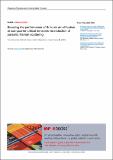Files in this item
Boosting the performance of Brillouin amplification at sub-quarter-critical densities via reduction of parasitic Raman scattering
Item metadata
| dc.contributor.author | Trines, Raoul | |
| dc.contributor.author | Alves, E P | |
| dc.contributor.author | Humphrey, Kathryn | |
| dc.contributor.author | Bingham, Robert | |
| dc.contributor.author | Cairns, R Alan | |
| dc.contributor.author | Fiuza, F | |
| dc.contributor.author | Fonseca, R A | |
| dc.contributor.author | Silva, L O | |
| dc.date.accessioned | 2021-11-22T16:30:10Z | |
| dc.date.available | 2021-11-22T16:30:10Z | |
| dc.date.issued | 2021-10-25 | |
| dc.identifier | 276749986 | |
| dc.identifier | 412871bb-83cd-4440-8af0-b02bc2ccfa39 | |
| dc.identifier | 85118920069 | |
| dc.identifier | 000739514000001 | |
| dc.identifier.citation | Trines , R , Alves , E P , Humphrey , K , Bingham , R , Cairns , R A , Fiuza , F , Fonseca , R A & Silva , L O 2021 , ' Boosting the performance of Brillouin amplification at sub-quarter-critical densities via reduction of parasitic Raman scattering ' , Plasma Physics and Controlled Fusion , vol. 63 , 124003 . https://doi.org/10.1088/1361-6587/ac2cd9 | en |
| dc.identifier.issn | 0741-3335 | |
| dc.identifier.uri | https://hdl.handle.net/10023/24382 | |
| dc.description | This work was supported by the STFC Central Laser Facility, the STFC Centre for Fundamental physics and by EPSRC through Grant EP/G04239X/1. We acknowledge PRACE for providing access to the resource SuperMUC based in Germany at the Leibniz Research Center. LOS acknowledges the support of the European Research Council (ERC-2015-AdG Grant No. 695088). | en |
| dc.description.abstract | Brillouin amplification of laser pulses in plasma has been shown to be a promising approach to produce picosecond pulses of petawatt power. A key challenge is preservation of the quality of the amplified pulse, which requires control of parasitic instabilities that accompany the amplification process. At high plasma densities ( >cr /4), ponderomotive filamentation has been identified as the biggest threat to the integrity of the amplifying pulse. It has therefore been proposed to perform Brillouin scattering at densities below ncr/4 to reduce the influence of filamentation. However, parasitic Raman scattering can become a problem at such densities, contrary to densities above ncr/4 where it is forbidden. In this paper, we investigate the influence of parasitic Raman scattering on Brillouin amplification at densities below ncr/4 . We expose the specific problems posed by both Raman backward and forward scattering, and how both types of scattering can be mitigated, leading to an increased performance of the Brillouin amplification process. | |
| dc.format.extent | 10 | |
| dc.format.extent | 2123705 | |
| dc.language.iso | eng | |
| dc.relation.ispartof | Plasma Physics and Controlled Fusion | en |
| dc.subject | Brillouin amplification | en |
| dc.subject | Laser-plasma interaction | en |
| dc.subject | Parametric instabilities, | en |
| dc.subject | High energy density physics | en |
| dc.subject | QC Physics | en |
| dc.subject | NDAS | en |
| dc.subject | NIS | en |
| dc.subject.lcc | QC | en |
| dc.title | Boosting the performance of Brillouin amplification at sub-quarter-critical densities via reduction of parasitic Raman scattering | en |
| dc.type | Journal article | en |
| dc.contributor.institution | University of St Andrews. Applied Mathematics | en |
| dc.identifier.doi | 10.1088/1361-6587/ac2cd9 | |
| dc.description.status | Peer reviewed | en |
This item appears in the following Collection(s)
Items in the St Andrews Research Repository are protected by copyright, with all rights reserved, unless otherwise indicated.

